I love mirror reflections. The symmetry they create, with the bottom of the photograph mimicking the top, almost automatically adds repetition and creates patterns, helping to unify the image and give it rhythm.
The photograph above is a good example. I made this about two weeks ago near Tioga Pass, with some fantastic clouds passing by late in the afternoon. It’s not a perfect mirror, as the water is slightly rippled, but it’s close enough. The clouds and their reflections form a big X through the picture, a pattern that echoes some of the diagonals in the mountains. This design draws your eye from the middle of the frame out to the corners, giving the image a sense of dynamic energy. None of that would happen without the mirror reflections.
On the other hand, I love rippled water too. Take the first two images below, made recently at Mono Lake. The water was rippled that morning, but not ruffled – an important distinction. If the wind is strong enough, the surface of a lake or pond gets ruffled or choppy, killing reflections. If the wind isn’t quite so strong you’ll get ripples, but each little wave will have a smooth surface, reflecting the sky and often creating wonderful textures, patterns, and colors in the water. With those first two Mono Lake images, the lines in the waves actually mimic the lines in the clouds, helping to emphasize the patterns.
With rippled-but-not-ruffled water you usually want a fast shutter speed to freeze the motion of the water and preserve its texture. For wide-angle lenses the shutter speed may not need to be all that fast; often 1/15th of a second is enough, and sometimes you can get away with 1/8 or 1/4. But if you’re zoomed in then you may need 1/60th of a second or more. The patterns and textures in the water can vary greatly as the wind changes, so timing is important.
With ruffled water, on the other hand, I usually prefer to use a slow shutter speed and smooth out the water. You’ll never get a great reflection with a ruffled surface, but smoothing it can create interesting effects, as in the third Mono Lake photograph below.
Whether rippled, ruffled, or smooth, you don’t need perfectly calm water when photographing lakes and ponds. A little bit of texture can be even more interesting than a mirror reflection.
— Michael Frye
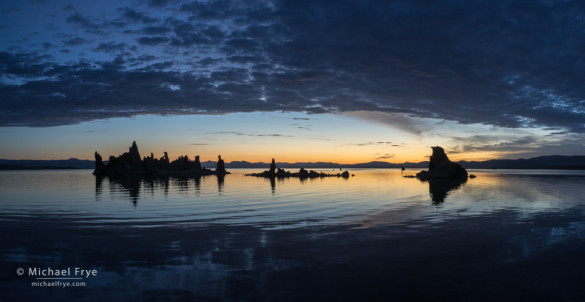
Pre-dawn light and clouds at South Tufa, Mono Lake. The shutter speed was 1/6th of a second, which was just fast enough to preserve the ripples.
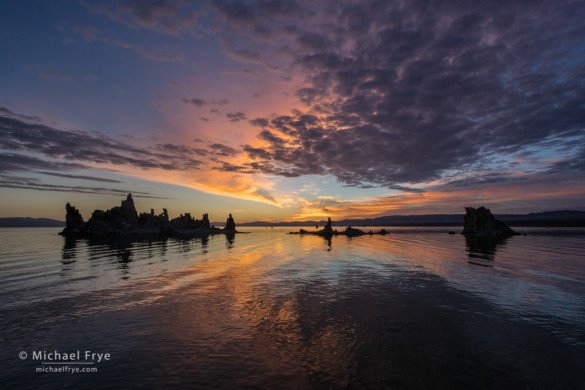
Sunrise at South Tufa, Mono Lake. I really like the texture in the water here. This is an HDR image (using the new HDR Merge in Lightroom 6), so it’s actually a blend of three different exposures, but the shutter speed for the lightest exposure was 1/45th of a second.
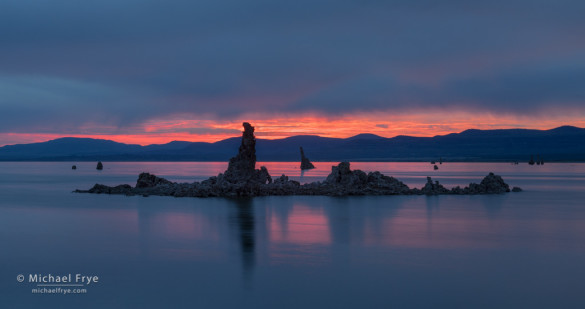
Sunrise, Mono Lake. I made this photograph a few weeks ago, on a morning when the water was more ruffled than rippled. With ruffled water you’ll never get a great reflection, but you can make the water look more interesting by using a slow shutter speed to smooth it out. Here I used a four-stop neutral-density filter to get a six-second shutter speed.
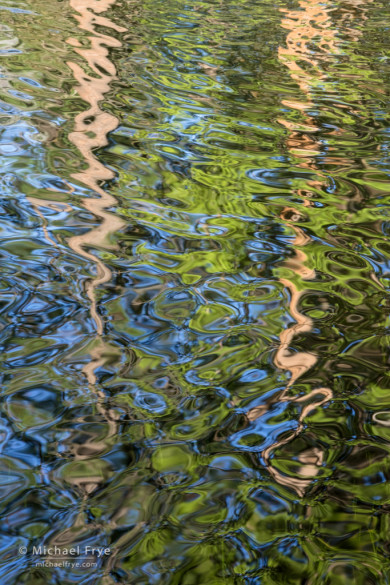
Reflections in the Merced River, Yosemite. I made this photograph in May, when the sun hit the trees on the opposite bank of the river and created wonderful abstract patterns in water. The shutter speed was 1/90th of a second.
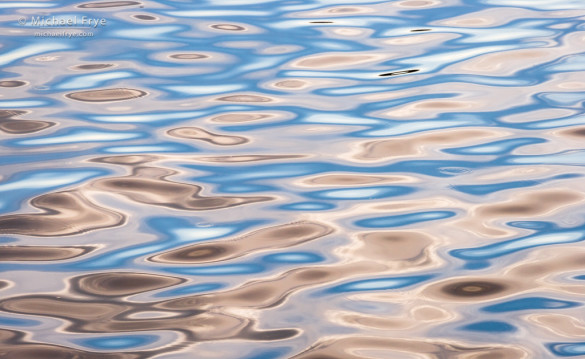
Reflections in an alpine lake, Yosemite. This image is from 2013, but I had to include it here because it’s such a good example of patterns created by ripples. In this case the water is reflecting blue sky and clouds, and the shutter speed was 1/125th of a second.
Related Posts: Back From the High Country; Cloud Patterns
Did you like this article? Click here to subscribe to this blog and get every new post delivered right to your inbox!
Michael Frye is a professional photographer specializing in landscapes and nature. He is the author or principal photographer of The Photographer’s Guide to Yosemite, Yosemite Meditations, Yosemite Meditations for Women, Yosemite Meditations for Adventurers, and Digital Landscape Photography: In the Footsteps of Ansel Adams and the Great Masters. He has also written three eBooks: Light & Land: Landscapes in the Digital Darkroom, Exposure for Outdoor Photography, and Landscapes in Lightroom 5: The Essential Step-by-Step Guide. Michael has written numerous magazine articles on the art and technique of photography, and his images have been published in over thirty countries around the world. Michael has lived either in or near Yosemite National Park since 1983, currently residing just outside the park in Mariposa, California.

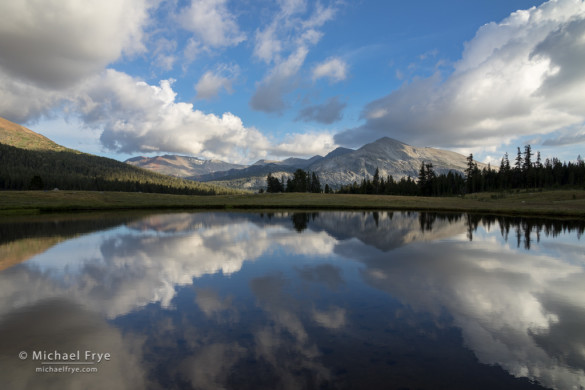








All very beautiful shots Michael! I really like the abstract reflections!
Thanks Michael!
MIchael,
You’ve done an excellent job differentiating the different types of reflective surfaces with regards to shutter speeds, etc. I’ve worked the long exposure at Mono Lake and gotten silky effects. The hurdle for average photogs may be using ND filters. I still use a screw one.
Thanks Andrew. The ND filter I referred to is not a graduated ND, so there’s no need for holders and such. Screw on versions are fine, and preferred as far as I’m concerned.
Michael-
Awesome photos!
When I look at your photos, I first try to evaluate your artistic intent, composition, layout, color hue & saturation, etc. Then I try to guesstimate your focal length, ISO, f stop, and shutter speed. It really helps me to grow as a photog to know the exposure setting.
Thanks for posting.
Bill
Thanks Bill! Guessing the settings is a good way to learn – good idea.
please do not tell folks where this is! it is such a peaceful place where there are very few footprints, hard to find these days